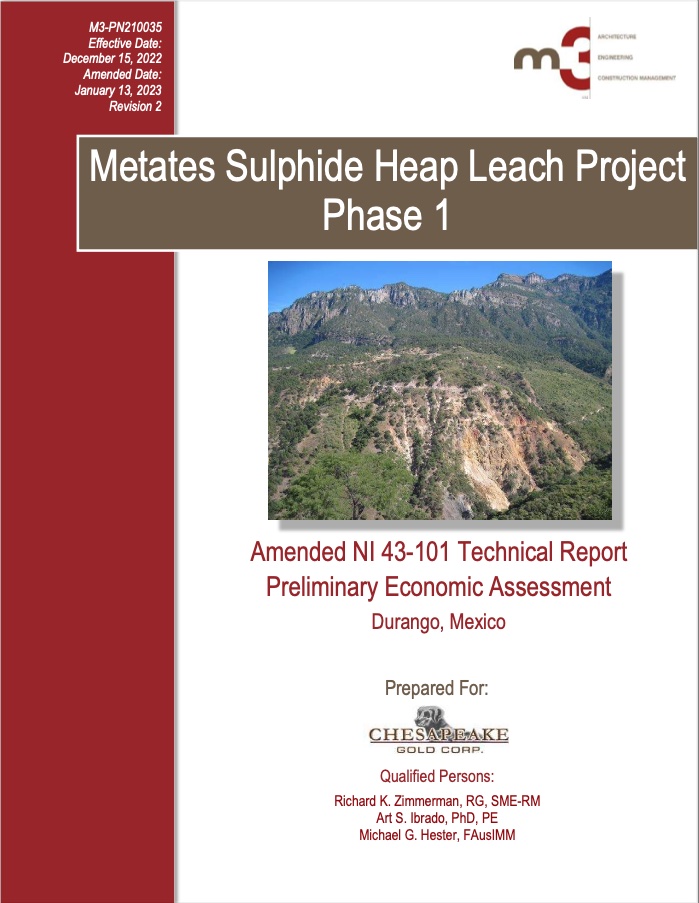Metates, Mexico
Metates – World Class Size & Scale¹
Metates is 100% owned by Chesapeake and is located 175 kilometers northeast of Mazatlán in Durango state and is one of the largest, undeveloped disseminated gold and silver deposits in the world¹. Mineral resources that are not mineral reserves do not have demonstrated economic viability. A NI 43-101 report by M3 Engineering & Technology Corp. of Tucson, Arizona outlines a total resource of over 20 million ounces of gold, over 550 million ounces of silver.
The measured and indicated mineral resource is 1.3 billion tonnes at 0.47 g/t gold and 12.9 g/t silver for 19.8 million ounces of contained gold and 542.0 million ounces of contained silver. Inferred mineral resource is an additional 62.2 million tonnes at 0.32 g/t gold and 9.0 g/t silver for 640,000 ounces contained gold and 18.0 million ounces of contained silver. Table 1 above shows the new resource statement for the Metates project.

The mineral resource is broadly divided into intrusive hosted and sediment hosted mineralization. In terms of measured and indicated mineral resource tonnes, about 80% of the resources are sediment hosted and 20% intrusive hosted. The mineral resources are based on a block model developed by Independent Mining Consultants (“IMC”) during July 2014. The results of the recent metallurgical core drilling program reported in the news release since 2021, have not been included in this block model.
The measured, indicated, and inferred mineral resources reported are contained within a floating cone pit shell, and are compliant with the “reasonable prospects for economic extraction” requirements of National Instrument 43-101 Standards of Disclosure for Mineral Projects (“NI 43-101”). The mineral resource cone shell is based on a gold price of US$1,600 per ounce and silver at US$20 per ounce.
1. Mexico’s biggest undeveloped gold deposits Published: Bnamericas -Tuesday, November 24, 2020
The Future: Developing Metates as a Low cost, Scalable Sulphide Heap Leach Mine
Click Image to enlarge
In January 2021, Chesapeake acquired Alderley Gold Corp., a private British Columbia mining technology company. With the acquisition of Alderley, Chesapeake gained access to a proven and innovative sulphide heap leaching technology together with certain asset rights and proprietary databases, creating the path towards a new growth oriented and innovative gold and silver producer. Chesapeake will now focus on progressing the Metates project towards production using the Technology in a heap leach operation.
Chesapeake has conducted preliminary testing on several samples from the Metates project. Metallurgical test results indicated the process will promote the oxidation of the sulphides to a level that will allow the subsequent leaching and recovery of gold and silver. With the Technology, the development of Metates as a heap leap operation will no longer envision autoclave circuits leading to significantly lower capital and processing costs, stronger overall project economics and a greatly reduced environmental footprint.
HIGHLIGHTS OF PHASE 1 PEA:
An updated PEA on Metates outlining the option for a new low capital cost, scalable sulphide heap leach operation was released in mid 2021 (https://chesapeakegold.com/2021/07/chesapeake-gold-announces-strong-pea-results-for-phase-1-heap-leach-mine-at-metates-with-pre-tax-npv-of-us1-1-billion-c1-4-billion-and-35-irr/).
(All financial figures are in U.S. dollars unless otherwise noted)
- Compelling Project Economics: Pre-tax NPV of C$1.43 billion (US$1.14 billion) and 35% IRR at $1,600 per ounce gold and $22 per ounce silver at a 5% discount rate, over a 31-year mine life (“LOM”).
- Production Metrics: Average annual production of over 110,000 ounces of gold and 2.5 million ounces of silver during the first 15 years. All-in sustaining cost (“AISC”) of $748 per gold ounce with a LOM low stripping ratio of 2.2:1.
- Significant Cash Flow: Average annual pre-tax free cash flow of $113 million in the first 15 years, and cumulatively $2.7 billion LOM.
- Initial Capital Cost and Payback: The PEA contemplates an initial capital cost of $359 million, including $64 million in contingency costs. Payback 2.5 years.
- Scalable Operation: Phase 1 15,000 tpd mine is expandable to 30,000 tpd, to bring production forward and reduce the 31-year LOM.
- Resource Optionality: The PEA only focuses on the higher-grade intrusive hosted portion of the Metates orebody, which represents less than 20% of the total mineral resource.
The Phase 1 Heap Leach PEA demonstrates strong financial performance and rapid capital payback developing Metates as a sulphide heap leach operation. The site’s simplified process flowsheet, compact footprint and proximity to key infrastructure contribute to the project’s low initial capital cost. The PEA forecasts early cash flow generation which supports future expansions that can be developed by the Company. Excellent upside optionality exists to scale up future production to potentially take advantage of the entire resource.
Innovative & Disruptive Processing Technology
Demand for gold & silver as a store of value continues to rise steadily with excessive growth in global money supply. However, precious metal mining has not kept pace and we are now mining lower grades ores today than at any time in history. World class deposit discovery rates are falling, existing oxide resources are being depleted, and a growing number of new mines use much higher-cost and technically challenging mining and processing methods.
These factors, combined with stricter environmental and permitting regulations, as well global water supply issues are significant headwinds for the precious metals mining industry.
Heap Leaching
Heap leaching, although in use for centuries as a means to economically extract valuable metals from ore, has now gained considerable popularity and large scale adoption in the mining industry in recent decades. It is most common as a processing method to extract gold, silver, copper, nickel and uranium.
At a high level, the process involves mining the ore, crushing (if necessary), placing ore on a lined pad, using appropriate chemical reagents to dissolve target metals, collecting leachate material and processing the solution to recover valuable metals, while recycling the barren solution back to the heap.
Click Image to enlarge
Economic Advantages
- Simplified design and equipment requirements
- Lower capital and operating costs and thus applicable to low-grade ore
- Quicker construction timelines
- Rapid payback
Environmental & Permitting Advantages
- No tailings disposal
- Significantly less water consumption
- Significantly less power consumption / carbon dioxide emissions
The Future: Recent Developments Allow For the Use of Heap Leaching Technology to Process Primary Sulfide Ores
The gold & silver mining industry is finally reaching a turning point. Surface oxide deposits are being rapidly depleted and miners are now forced to innovate and turn attention towards sulphide orebodies that were traditionally thought to be more expensive to process using existing technologies. The vast majority of total global ore types are sulfide in nature. The solutions however lay right under our noses as the copper industry, as one example, has been oxidizing and heap leaching sulphides for decades.
Borrowing from similar concepts, Chesapeake intends to be a leader in oxidizing and heap leaching sulphide precious metal ores, starting with application of the technology on Metates.
Amended NI 43-101 Technical Report Preliminary Economic Assessment
Chesapeake Vice President Development and Metates Project Manager, Gary Parkison, is the Qualified Person under the terms of NI 43-101 responsible for the verification of the technical work and data acquisition. Justin Black, PE, Rick Zimmerman, RG and Dr. Art Ibarra, PE, Project Manager with M3 and Mike Hester F AUS IMM, Vice President of IMC are responsible for the NI 43-101 PFS, PEA and resource estimate.




